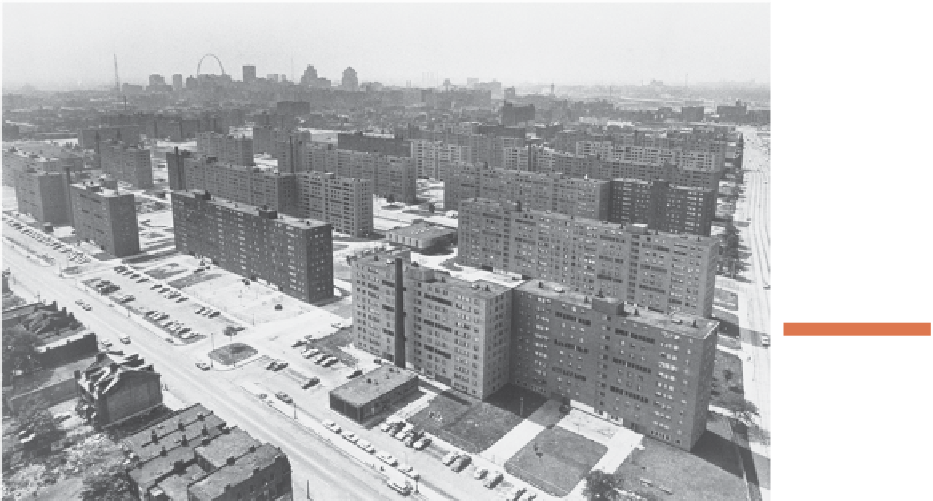Geography Reference
In-Depth Information
Figure 9.40
St. Louis, Missouri.
This photo taken in 1971
captured a view of the massive Pruitt-Igoe housing
project, before it was demolished in 1972. Pruitt-
Igoe was designed in 1951, and by 1972 the rampant
crime in the project's 33 apartment buildings solidifi ed
the image of this public housing project as a failure.
© Corbis-Bettmann.
In Europe and North America, gated communities
are not only for the wealthy and privileged. Especially since
September 11, people have a growing desire to feel safe at
home, and this is just as true of middle and lower classes as it
is of the rich. Some urban planners have encouraged govern-
ments to recast low-income housing as small communities,
gated from each other, in order to reduce the fl owthrough
traffi c and crime associated with it. Cities have torn down
the enormous high rises, typically ridden with crime and
referred to as “the projects” such as Cabrini Green in
Chicago and Pruitt-Igoe in St. Louis, in an effort to remake
the spaces of the poor into “defensible” spaces (Fig. 9.40).
Urban planners want to gate middle-income and
low-income neighborhoods in order to create a sense of
community and to make the spaces “defensible” from
undesired activities such as drug dealing and prostit
example, Algeria was a colony of France, and now Paris
and other French cities have distinct Algerian neighbor-
hoods. Similarly, London (the United Kingdom) has a
Jamaican neighborhood, and Madrid (Spain) has a dis-
tinct Moroccan neighborhood, refl ecting their colonial
ties with these now sovereign countries. Other European
countries cultivated relationships with countries outside
of Europe after the colonial era. For example, after World
War II, Germany invited young men from Turkey to
migrate to Germany as guest workers (see Chapter 3). Cities
in Germany, such as Frankfurt, have distinct Turkish
neighborhoods. Current immigration to countries in
Europe typically focuses on the cities. And most of the
migrants to European cities come from the global periph-
ery or from eastern Europe, not from other countries in
western Europe.
Migration to Europe is constrained by government
policies and laws. Many western European cities have
public housing zones that were built after World War II
following the devastation of the war years. Governments
in Europe are typically much more involved in the social
rights of people, such as health care and housing than the
United States government. European cities are also much
older than American cities, and when the cities were laid
out they were designed for foot and horse traffi c, not auto-
mobiles. Thus, European cities are typically more com-
pact, densely populated, and walkable than American cit-
ies. European cities also have historic city centers where
much of the city's history took place and is preserved and
to which tourists are attracted today. Rather than the sky-
scrapers that are typically the focal point of downtown in
American cities, a historic city center is the focal point of
downtown in European cities and skyscrapers are reserved
ution.
One of the best-documented cases of gating a middle-
income community is the Five Oaks district of Dayton,
Ohio, a neighborhood that is about 50 percent African
American and 50 percent white and has a high rate of rent-
als. Urban planner Oscar Newman encouraged planners
in Dayton to divide the 2000 households in the Five Oaks
district into ten smaller, gated communities with restricted
access. The city turned most of the residential streets in
each of these mini-neighborhoods into cul-de-sacs. They
have experienced a serious reduction in crime, along with
an increase in housing sales and housing values.
Ethnic Neighborhoods in the European City
Ethnic neighborhoods in European cities are typi-
cally affi liated with migrants from former colonies. For











































